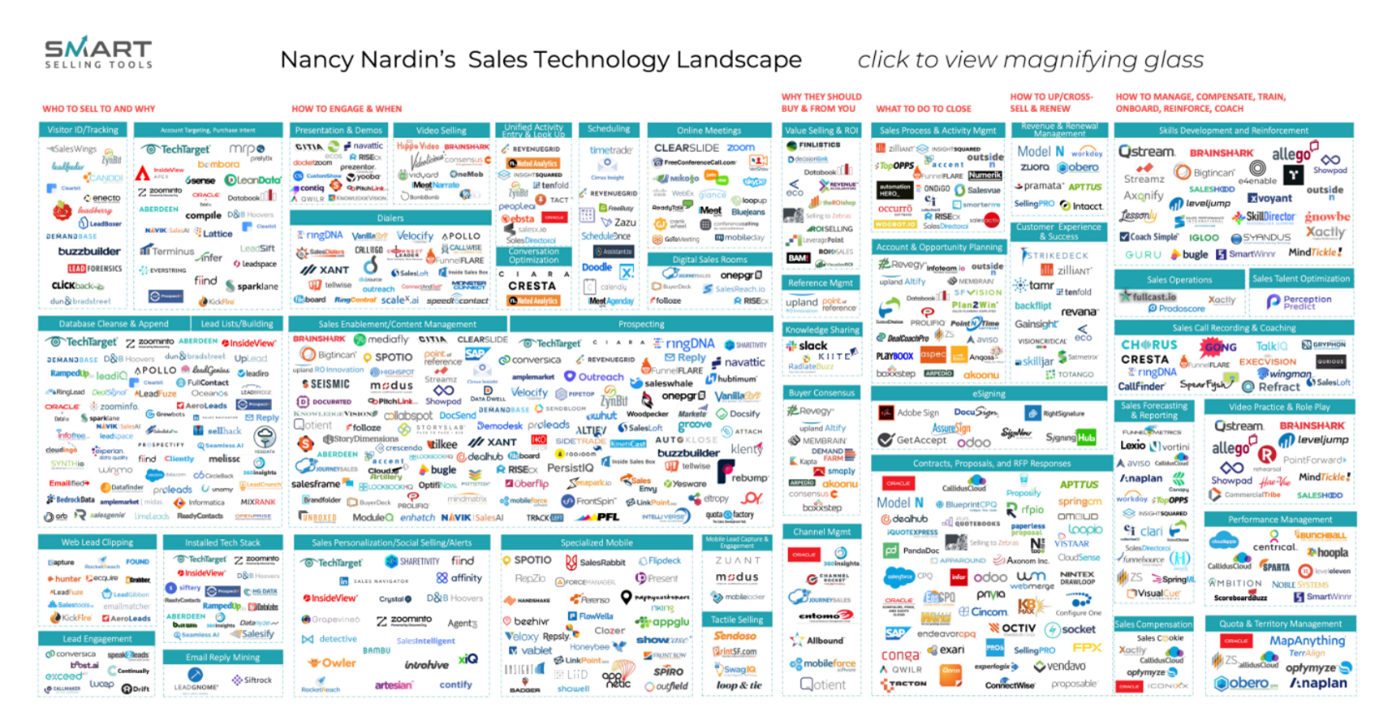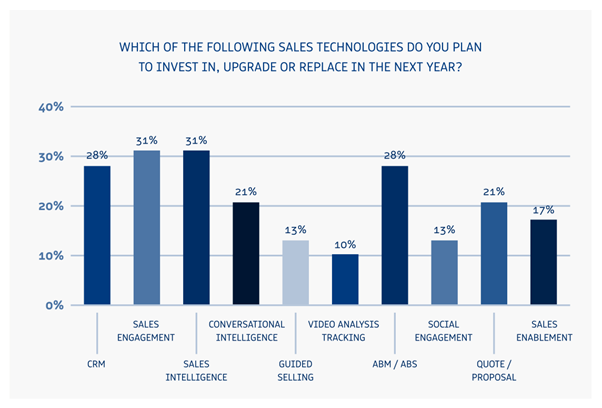57% of UK sales professionals say technology is important to closing deals. So, how do you build the ultimate SalesTech stack?

It can't just be a case of haphazardly glueing together some CRMs, hammering in some lead generation tools, all bandaged over with some AI, right?
Think more master craftsman, less cowboy builder. With companies using more and more technology to improve their sales productivity and win more deals, the perfect SalesTech stack is more vital than ever.
In fact, it has been found that the average sales organisation uses 10 tools, and planned to add at least four more in the following year.
This means there's a risk of buying unnecessary tools and forcing them into the Jenga block-like stack you've created. Not ideal. Plus, how do you even place the necessary tools into your stack? Well, don't fret. We're here for you.
What is a Sales Stack?
Yep, starting right at the beginning. A sales stack is vital to modern sales, with 73% of salespeople using technology to close more deals. Plus, 97% of salespeople said that technology is either "important" or "very important" to their sales process.
So, a sales stack is the software and technology your sales team uses and needs to excel at its job. It can be used to generate leads, store contact data, build proposals, get signatures, and communicate effectively with the team and customers alike.
The best sales stack is made up of sales tools that can integrate, so your team can access the features and information they need seamlessly. If you're a sales rep, the right stack can save you time, effort, and resources in the long run, at every stage of the buyer journey.
If you're a sales leader, having a well-crafted stack can be the difference between average-performing teams and high-performing teams.
To build the correct stack for your team, you need to be aware of every step of the sales process. Then, you can figure out where steps can be simplified, shortened, or integrated. Remember, the goal is to close the most quality deals with the least amount of resources. The tools you use can help you take steps towards this goal.
What is the Current State of The Landscape?
- Half of all sales organisations in the UK have responded to the pandemic by increasing their investment in salestech, with another 52% saying they will grow their investment over the next year.

- 57% of UK sales professionals say technology is important to closing deals, while 38% say it is very important. It’s why almost a third are applying technology to sales planning, engagement, and enablement.
- Digital selling has now become a trend with 77% of sales professionals conducting more video meetings.
- 44% of sales professionals expect the buyers to be less responsive to sales outreach during the pandemic.
- 60% of sales professionals expect that they will struggle in hitting their quotas due to the decrease in closing deals.
- 75% of UK B2B sales organisations are increasing their investment in tools moving forward
- According to LinkedIn, the top technologies are:
- CRM tools (42%)
- Visual collaboration / demo tools (41%)
- Sales intelligence (40%)
- Sales planning (37%)
- Sales engagement (36%)
- Sales enablement (30%)
- Sales coaching (28%)
- 40% of sales professionals opt for warm outreach compared to 39% who lean more toward cold outreach in the midst of the pandemic.
- 81% of B2B buyers were worried about a recession in 2020, which was alleviated by 92% of salespeople stating that they would help B2B buyers navigate through the crisis.
- 70% of US-based sales managers agreed that managers’ capability to adapt to change is more important now compared to five years ago.
- 52% of UK B2B sales reps have never used digital signatures in their sales process (while only 18% have switched over to digital signatures only).
- 55% of sales professionals expect their sales pipeline to decrease.

How Do You Build a Sales Stack Your Team Will Use?
Just because you build it, doesn't mean your team will use it.
You can't just buy a bunch of tools and hope for the best. It's a bit more complex than that. If you want to create a sales stack which your team will use, then you should build it around their current sales process.
A well-defined sales process is what helps sales teams to close deals. The tools you purchase should turn this established, well-oiled process into something even more effective and impactful.
So, start with the process as a foundation, and use the tools as the walls, floors, windows, above the ground pool, bowling alley, etc. etc.
So, how can you understand your sales process? Well:
- Have clear, defined customer profiles
- Understand where your leads come from
- Define the best method to present your product to prospects
- Build a framework to handle common objections
- Understand your ideal follow-up timeframe
- Define which sales metrics matter most to your business
- Know which sales activities drive more deals to close.
Then, you can begin to ask:
- Which manual processes can be streamlined?
- Is there room for improvement in your engagement with prospects throughout the sales process?
- What can you do to improve your prospecting and generate quality leads?
- What can you do to maximise your conversions?
- What sales KPIs are you focusing on?
Which Tools Should Be Part Of Your Sales Stack?
Number One: Customer Relationship Management (CRM) software.
This is one of the big 'uns. First things first, you need the right customer relationship management software. Your priority should be engaging the customer in lasting and meaningful ways throughout the pipeline.
So, getting the correct CRM will not only allow you to track client relationships, from prospect to close, but will also mean increased retention, opportunities for upselling, and the chance to track and analyse data from customers. You'll also have the capacity to manage any new product releases.
Number Two: Forecasting Tool
One thing a CRM is unable to do well is forecasting. This provides insight into the level of sales a business might expect to reach monthly, as well as the potential growth in specific segments. It can also help to highlight new market opportunities.
Forecast numbers can help to estimate expected sales volume, so your team can adjust their goals and aims. These forecasts can help marketing too; forecasting can help provide insights into customer engagement, so campaigns can be developed more accurately.
Overall, a good forecasting tool can provide a level of confidence in the company's direction and momentum.
Number Three: Prospecting and Lead Generation
Quantity is not always better than quality in sales. So, when it comes to leads, the amount you get isn't an indication of success. Focusing on getting high-quality leads allows reps to spend more time nurturing valuable clients, who are more likely to convert.
Prospecting and lead gen tools help to streamline the prospecting process and provide data to help teams uncover these leads. Some tools even have the ability to automate parts of the nurturing process, so you can build a relationship without spending countless hours sending message after message.
Number Four: Sales Enablement and Automation
No more manual sales here. When you're reviewing each step and part of your sales stack to identify gaps, you also need to be considering which parts you can automate. Your CRM might even be able to help you out in this regard before you go out and buy a standalone piece of software.
You might consider using sales enablement in:
- Emails. Email sequences allow you to personalise and automate follow-up emails to your prospects. You can create email templates within your CRM and customise them to reduce response time, and can even track email performance easily.
- Prospecting. This is a big time sink. As a result, you can use an email template that has a scheduling link, allowing your clients to approach you in their own time.
- Live Chat. Chatbots allow you to contact a prospect just at the right time. If they're floating around your pricing page, they can be engaged within the moment using direct messaging.
- Content. A case study or blog post can help a champion prospect convince their executive. So, to make sure you're getting the most from your use cases, track usage in your CRM and use that data to identify and reach out to potential case study or blog feature customers.
- Reporting. It is a good idea to standardise what KPIs your team will be held to, and automate the tracking of those numbers in your CRM or reporting software.
Number Five: Sales Readiness Tool
Different from sales enablement, sales readiness goes beyond training and content. Instead, it encompasses a continuous and consistent process of creating and executing strategies to ensure your team's effectiveness and preparedness. This ensures your team is aligned on sales processes and methodology and provides visibility into how it's translating into sales forecasts.
Without a sales readiness tool that provides updates to messaging and training, sales won't be able to engage successfully with a client, which means they won't follow through on outcomes, and can't reach the results forecasted.
Sales readiness is the underlying platform which gives CROs the ability to operationalise what needs to happen to forecast moving forward.
Number Six: Scheduling
No more tedious back and forth emails. No more scheduling slogs. With an appointment scheduling piece of software, your prospects can schedule meetings when they want, which makes it far less painful to get a meeting on the books.
Number Seven: Demos
The right presenting software can help you shape up your pitch. So, choosing the correct one is key. Make sure it's user-friendly and doesn't require a designer to make any minor adjustment. It should also be easily shareable, and compatible across devices.
Number Eight: Learning Management Systems
Before your sales team is able to achieve real success, they need to be trained. Sales training can be a key indicator of success, but 26% of sales reps report their sales training to be generally ineffective.
Learning management systems ensure your sales team have the knowledge they need to deliver sales results, by streamlining product training, onboarding, standards training, and updating training material.
Number Nine: Sales Reporting and Management
These tools help sales managers and their teams track what works in the sales process and, more importantly, what doesn't. Can your sales managers see which members of their teams are likely to hit their goals? Which leads are most likely to convert? If not, sales and reporting tools provide all this data, and more.
If you have several platforms in your sales stack, getting all that data in one place can be a challenge, writing out the use of a CRM in this case. So, this is when a standalone reporting tool comes in handy.
Don't Over-stack Your Stack
Your stack should be filled with useful tools. But not too overfilled. Taking on too many tools at once can lead to unused features and wasted money. So, be strategic. There are plenty of tools which can serve multiple strategic categories based on their feature set and functionality.
It is the quality of the integration it provides, and the information it generates, that determines the tool's value. It is very easy to underinvest in some tools and over-invest in others. So, the best thing to do is to choose a tool stack that does not determine your process, but works with it instead.
How to Build Your Sales Tech Stack
Building a good tech stack can feel overwhelming. But it doesn't have to be. If you're building it from scratch or adding to your current stack, it's difficult to know where to start.
So, before you jump in feet first, it's important to know what tools you need, what tools are nice-to-haves, and what tools are just a result of "shiny toy syndrome".
So, it's a good idea to ask yourself:
- What sales tools do I currently use, and are they working well? For example, does your CRM help or hinder your sales team? If it does, any additions to your sales stack need to be able to integrate with it.
- Is your current sales process hitting roadblocks? What issues are you facing, and what tools will help you solve them?
- What tools does your company currently use, and can you consider integrations?
- What are your company's long-term growth goals? A tool which works for a small team, might not work so well for a larger one.
- Does the tool offer training?
- What are the critical features you need?
- What tools can fill gaps, and bring your sales activities to the next level of maturity?
Does Your Sales Stack Fit You, or Do You Fit Your Sales Stack?
your sales process is unique, so your sales tech stack should be too. Building the right stack can help your team exponentially, by streamlining the process and plugging leaks in the sales funnel.
So, it's all about finding the right tool for any challenge your team faces. There are a lot of challenges out there, but luckily there's a tool for almost every difficulty.
But be aware not every shiny tool will be the right fit for your business. So, you can look at what is working for other sales teams, and experiment. Don't be hesitant to test new products, and see if they fit your teams. But on the other hand, don't worry about ditching tools that don't work for you.
Then, it's important to implement a training programme, to make sure your team is on the same page. Training can improve adoption rates significantly, and help your team close more deals. Now, that's more master crafter, less cowboy builder right there.
